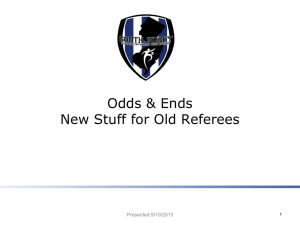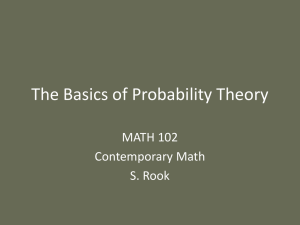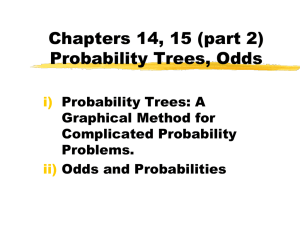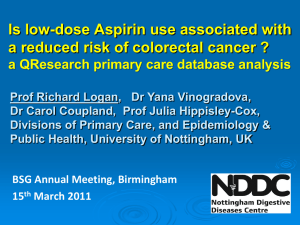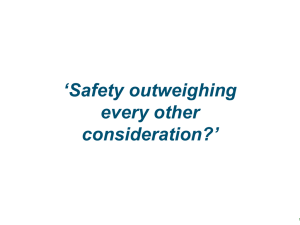ObsDatAna2CatVars
advertisement
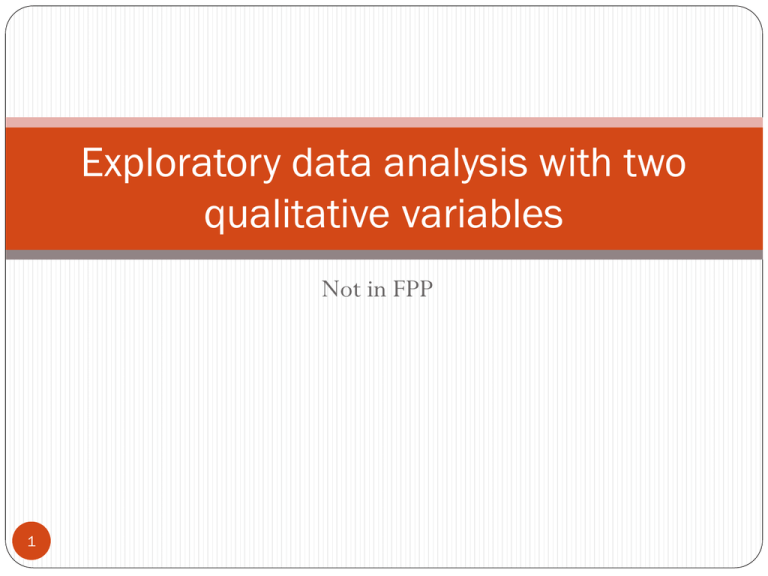
Exploratory data analysis with two qualitative variables Not in FPP 1 Exploratory data analysis with two qualitative/categorical variables Main tools Contigency tables Conditional, marginal, and joint frequencies 2 Motivating example Surviving the Titanic Was there a class discrimination in survival of the wreck of the Titanic? “It has been suggested before the Enquiry that the third-class passengers had been unfairly treated, that their access to the boat deck had been impeded; and that when they reached the deck the first and second-class passengers were given precedence in getting places in the boats.” Lord Mersey, 1912 3 Titanic: Class by survival 1st Class 4 2nd Class 3rd Class Crew Dead 122 167 528 696 1513 Alive 203 118 178 212 711 325 285 706 908 2224 Titanic: Marginal frequencies % Dead = 1513/2224 = 0.68 % Alive = 711/2224 = 0.32 % in first class = 325/2224 = 0.14 % in second class = 285/2224 = 0.13 % in third class = 706/2224 = 0.32 % crew = 908/2224 = 0.41 5 Titanic: Conditional frequenceis % (Alive | 1st) % (Alive | 2nd) % (Alive | 3rd) % (Alive | Crew) = 203/325 = 0.625 = 118/285 = 0.414 = 178/706 = 0.252 = 212/908 = 0.233 Based on these frequencies does there appear to be class discrimination? 6 Titanic: Class by person type 1st Class Child. 7 2nd 3rd Crew Class Class 6 24 79 0 109 Wom. 144 93 165 23 425 Men 175 168 462 885 1690 325 285 706 908 2224 Titanic: percentage of men in each class % (Man | 1st) % (Man | 2nd) % (Man | 3rd) % (Man | Crew) = 175/325 = 0.54 = 168/285 = 0.59 = 462/706 = 0.65 = 885/908 = 0.97 There are larger percentages of men in third class and crew 8 Surviving the Titanic A reason for class differences in survival: Larger percentages of men died 3rd class consisted of mostly men. Hence, a larger percentage of 3rd class passengers died. Once again keep in mind possible lurking variables that could be driving the relationship seen between two measured variables 9 Relative risk and odds ratios Motivating example Physicians’ health study (1989): randomized experiment with 22071 male physicians at least 40 years old Half the subjects assigned to take aspirin every other day Other half assigned to take a placebo, a dummy pill that looked and tasted like aspirin 10 Physicians’ health study Here are the number of people in each cell: Heart attack 11 No heart attack Aspirin 104 10933 11037 Placebo 189 10845 11034 293 21778 22071 Relative risk y1 y2 x1 a b a+b Risk of y1 for level x1=a/(a+b) x2 c d c+d Risk of y1 for level x2=c/(c+d) a+c b+d 12 a/(a + b) Relative risk = c /(c d) Relative risk for physicians’ health study Relative risk of a heart attack when taking aspirin versus when taking a placebo equals 104 /(104 10933) RR 0.55 189 /(189 10845) People that took aspirin are 0.55 times as likely to have a heart attack than people that took the placebo Or people that took placebo are 1/0.55 = 1.82 times as likely to have a heart attack than people that took aspirin 13 Odds ratios y1 y2 x1 a b Odds of y1 for level x1=a/b x2 c d Odds of y1 for level x2=c/d a/b Odds ratio= c /d 14 Odds ratios for physicians’ health study Relative risk of a heart attack when taking aspirin versus taking a placebo is 104 /(104 10933) RR 0.55 189 /(189 10845) Odds of having a heart attack when taking aspirin over odds of a heart attack when taking a placebo (odds ratio) 104/10933 OR 0.546 189/10845 15 Interpreting odds ratios and relative risks When the variables X and Y are independent odds ratio = 1 relative risk = 1 When subjects with level x1 are more likely to have y1 than subjects with level x2, the odds ratio > 1 relative risk > 1 When subjects with level x1 are less likely to have y1 than subjects with level x2, then odds ratio < 1 16 relative risk < 1 Which one should be used? If Relative Risk is available then it should be used In a cohort study, the relative risk can be calculated directly In a case-control study the relative risk cannot be calculated directly, so an odds ratio is used instead Case-control studies is an example. They compare subjects who have a “condition” to subjects that don’t but have similar controls In this type of study we know %(exposure|disease). But to compute the RR we need %(disease|exposure). Recall that RR = %(disease|exposure)/%(disease|placebo) Not available in more complex modeling (logistic regression) 17 Odds ratio vs relative risk When is odds ratio a good approximation of relative risk When cases are representative of diseased population When controls are representative of population without disease When the disease being studied occurs at low frequency Of itself, an odds ratio is a useful measure of association 18 Relative risk vs absolute risk % smokers who get lung cancer: 8% (conservative guess here) Relative risk of lung cancer for smokers: 800% Getting lung cancer is not commonplace, even for smokers. But, smokers’ chances of getting lung cancer are much, much higher than non-smokers’ chances. 19 Simpsons paradox When a third variable seemingly reverses the association between two other variables Hot hand example 20



